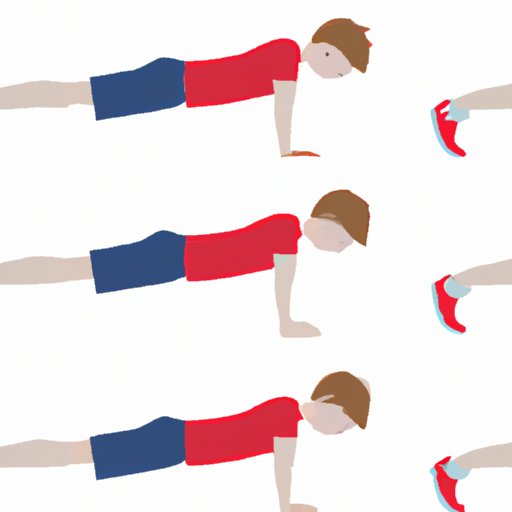
Perfecting Your Push-Up: A Step-by-Step Guide to Proper Form
Push-ups are one of the most basic yet effective exercises for building upper body strength and core stability. They require no equipment and can be done anywhere, making them a convenient addition to any workout routine. However, performing push-ups with incorrect form can lead to injury and hinder progress. In this article, we will break down the push-up into step-by-step instructions, identify common mistakes to avoid, suggest modifications for beginners, elaborate the benefits, introduce variations, and offer tips on how to progress in this exercise.
Step-by-Step Guide
The following are the step-by-step instructions for performing the push-up exercise with proper form:
- Place your hands shoulder-width apart on the ground, fingers facing forward.
- Place your feet together and extend them backward, balancing on your toes.
- Ensure your body forms a straight line from your head to your heels and keep your core tight.
- Bend your elbows, lowering your chest towards the ground and keeping your elbows slightly tucked towards your torso.
- Press back up, keeping your core engaged and maintaining a straight line from your head to your heels.
- Repeat this motion for the desired number of reps while maintaining proper form.
It is essential to maintain proper form while performing the push-up to maximize its benefits and avoid injury. A common mistake people make is sagging their hips or arching their back, which puts unnecessary strain on the lower back. Another common mistake is flaring out the elbows, which causes unnecessary stress on the shoulder joint. To avoid these mistakes, keep your core engaged, and maintain a straight line from your head to your heels.
Common Mistakes to Avoid
Identifying and avoiding common mistakes is crucial in performing push-ups safely and effectively. Here are some common mistakes that people make while performing push-ups:
- Sagging hips or arching the back
- Flaring the elbows out towards the sides
- Not engaging core muscles
- Letting the neck drop or looking forward
- Knees touching the ground or using momentum to complete the movement
These mistakes can lead to injury and hinder progress. To avoid this, engage your core muscles, keep your back straight, your elbows tucked towards your body, and look forward while performing the push-up.
Modifications for beginners
If you’re new to push-ups or find them physically challenging, there are several modifications you can use to help you progress to a traditional push-up. Here are some push-up variations for beginners:
- Wall push-ups: Stand facing a wall and place your hands on the wall at shoulder-width apart. Lean into the wall and push back up.
- Knee push-ups: Start on all fours, bringing your knees behind your hips. Lower yourself down towards the ground, keeping your knees touching the floor and push yourself back up.
- Modified plank push-ups: Start in a plank position on your knees and hands. Lower yourself down towards the ground, keeping your core engaged, and push yourself back up.
When performing these modified push-ups, focus on proper form, and maintain a straight line from your head to your knees while engaging your core muscles.
Benefits of push-ups
Push-ups offer numerous benefits. They are an excellent way to increase upper body strength, tone the chest, shoulders, and triceps muscles and improve core stability and posture. Regular push-up exercises will also help in improving your cardiovascular health as it strengthens your heart muscles and increases blood circulation. Performing push-ups can also help in promoting better sleep quality and a more moderate level of stress.
For example, the pectoral muscles in your chest, the deltoids in your shoulders, and the triceps in your arms are the primary muscles used to complete a push-up. Stronger these muscles, in turn, makes physical activity, such as carrying bags, going up and downstairs, or pushing and pulling activities, more comfortable and more manageable. Coordination, reflexes, and balance improve as well.
Variations of push-ups
Once you have mastered the traditional push-up, you may want to introduce variations that target different muscles. Here are some popular push-up variations:
- Diamond push-ups: Place your hands to together into a diamond shape directly beneath your breastbone.
- Incline push-ups: perform push-ups with your hands elevated on a bench or other raised surface.
- Decline push-ups: Perform a push-up with your feet elevated on a bench to increase the intensity of the exercise
- One-arm push-ups: Perform the push-up with one hand stationary and the other hand planted on the floor.
Each of these variations places additional stress on particular muscles, such as the triceps, pectorals, or shoulder muscles. It is essential to maintain proper form while performing any of these variations to avoid injury and maximize benefits.
Tips for Progress
To reach new fitness goals, it is essential to challenge yourself and continually strive for improvement. Here are some tips for progressing in push-ups exercises
,
- Increase the number and frequency of push-ups as you get stronger.
- Add weights or resistance bands to increase the intensity of the exercise.
- Attempt more difficult variations to target different muscles or increase the intensity of the exercise.
- Incorporate push-ups into a progressive overload training program.
It is essential to progress gradually to maintain proper form and avoid injury. Remember to listen to your body and rest when needed.
Conclusion
In conclusion, push-ups are an effective exercise for building upper body strength and core stability. By maintaining proper form, avoiding common mistakes, using modifications, and incorporating variations, you can maximize the benefits of push-ups. Progressing gradually and challenging yourself will enable you to reach new fitness goals and achieve the desired results. Incorporating push-ups into your workout routine can enhance your physical fitness and improve your overall health and well-being.





